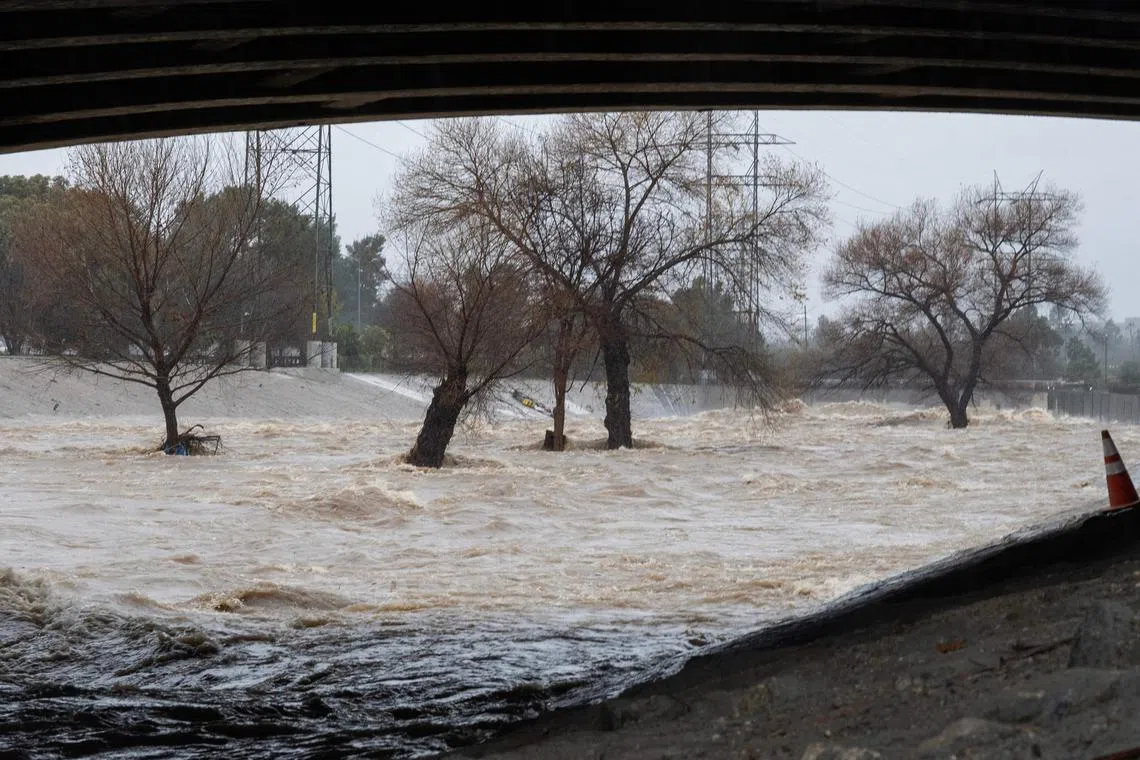What are atmospheric rivers, and why do they hit California especially?
Sign up now: Get ST's newsletters delivered to your inbox

Atmospheric rivers, weather patterns notable for their shape, will become stronger and more frequent due to climate change.
PHOTO: AFP
Follow topic:
LOS ANGELES – Winter storms that strike the US West Coast can dump rain non-stop for days, in the worst cases, triggering floods and mudslides. The strongest of these are usually a phenomenon known as atmospheric rivers, weather patterns notable for their shape and the sheer volume of water they can deliver.
While they can strike anywhere, California typically gets the planet’s most punishing atmospheric rivers and is currently being doused by a version known as the Pineapple Express. The storms are not new, but they have been getting more attention in recent years as researchers learn more about how to track them and climate change potentially makes them stronger.
1. What is an atmospheric river?
These weather patterns get their name primarily from their shape. They are long, narrow bands of water vapour traversing the sky, a few hundred kilometres wide and stretching for thousands of kilometres. They sometimes span an entire ocean, and can carry an enormous amount of water. One study recorded atmospheric rivers delivering as much as 26 cubic km per day, about 15 times the amount of water the Mississippi River dumps into the Gulf of Mexico every day.
2. When and where do atmospheric rivers occur?
Atmospheric rivers tend to happen during the cooler seasons. They can occur anywhere in the world, but the strongest ones usually come off the Pacific Ocean to dump rain on the US West Coast. The vast expanse of the planet’s biggest ocean provides plenty of moisture for atmospheric rivers. And global wind patterns generally flow west-to-east, driving Pacific storms towards North America.
3. Are atmospheric rivers dangerous?
The heavy rain from atmospheric rivers can overwhelm rivers and saturate hillsides, triggering floods and landslides. They are responsible for most of the flooding in California. But they are not all bad. They also deliver needed precipitation to a region that depends on heavy winter storms to fill reservoirs and create the mountain snowpack that provides water in the dry summer months. Atmospheric rivers provide as much as 50 per cent of California’s annual rainfall, according to Mr Brian Hurley, a senior branch forecaster with the US Weather Prediction Centre. Researchers created a rating scale to evaluate the storms, based on the amount of water vapour they carry and how long they linger in a specific area. A Category 1 atmospheric river is considered weak and mostly beneficial, while a Category 5 storm is exceptional and hazardous.
4. What is the Pineapple Express?
Atmospheric rivers that start in warmer latitudes can pick up more moisture. The Pineapple Express refers to a well-documented atmospheric river that periodically forms near Hawaii and then gathers strength as it barrels towards California. When it hits the West Coast and slams into the mountains, it can stall, wringing out water across the state.
5. How is climate change affecting atmospheric rivers?
Warmer air can hold more moisture, so the warming planet means there is more chance of stronger atmospheric rivers. More of the precipitation in California in recent years has been coming from these storms as they become more common. “If it’s raining in Southern California in the winter, it’s probably an atmospheric river,” said Mr Hurley. BLOOMBERG

